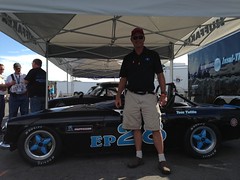n the beginning, there was darkness….
In 1945, former driver and famed engineer Donald Healey started Donald Healey Motor Company Ltd at an old RAF based in England. This company would eventually produce the famed Austin-Healey 3000 in 1959, a beautiful and race-proven car. Despite respectable sales, this car was discontinued in 1967.
Seeing room in the market left by the demise of the 3000, California car dealer Kjell Qvale contacted Donald Healey and Jensen Motors. Jensen, a coach builder from England, had actually built some bodies for the Austin-Healey. The three groups entered a joint venture and the Jensen Healey was born.
With the body spoken for, it came to the group to choose its heart. Several engines were considered and struck down for various reasons. In the end, it was settled that the driving force of the Jensen Healey would be supplied by Lotus. This motor was originally designed for the Lotus Esprit and Elite as a V8, and was simply split into inline-4 form for the J-H. Despite being an old motor sourced from Lotus, it was actually pretty advanced for its time, putting out 144hp with four valves per cylinder and dual overhead cams – something NASCAR still hasn’t figured out.
Unfortunately, despite the popularity of the car in the US, its life was made short by a deadly mix of inflation, labour strikes, and currency fluctuations. In 1973, a Jensen Healey could be had for $4500. The same car the next year would cost nearly $9000. It’s no wonder that the sales dropped off quickly and sadly the company sought liquidation in 1975 and shut its doors in May 1976.
- Years of Manufacture: 1972 – 1975
- Number Built: 10,000+
- Chassis/Body: Steel, Monocoque
- Exterior Dimensions:
- Total Length: 13 ft. 6 in. (4113 mm)
- Total Width: 5 ft. 3.25 in. (1606 mm)
- Height: 3 ft. 11.75 in. (1210 mm)
- Wheelbase: 7 ft 8 in. (2337 mm)
- Ground Clearance: 5 in. (127 mm)
- Kerb Weight:
- 2650 lbs. (1097 kg)
- Transmission:
- 5 Speed Manual Transmission driving rear wheels
- Ratios:
- 1st: 11.63:1
- 2nd: 7.42:1
- 3rd: 4.83:1
- 4th: 3.73:1
- Reverse: 12.37:1
- Rear Axle Ratio:Maximum Speed: 193 km/h / 120 mph
- Hypoid rear axle
- Ratio: 3.73:1
- Fuel Consumption: n/a
- Fuel Tank Capacity: n/a
- Performance (0-60 mph): 8.7 seconds
- Lotus 907 Straight 4 Engine:
- Four cylinder, inline slant 45°
- Capacity: 1.973 litre / 120.5 ci /1973cc
- Type: Conventional, watercooled four stroke, reciprocating piston type, double overhead camshafts, four valves per cylinder
- Configuration: Front mounted, longitudinal
- Head: Aluminum alloy block and head
- Fuel System: Twin Dell’orto Carburetors
- Bore and Stroke: 95.2 mm (3.75 in.) / 69.3 mm (2.73 in.)
- Power: 144 bhp / 107 KW @ 6500 rpm
- Torque: 182 Nm / 134 ft lbs @ 5000 rpm
- Compression Ratio: 8.4:1
- Fuel Tank:
- 11 imperial gallons (50 litres)
- Ignition and Electrical:
- SU Electric Fuel Pump
- 12 volt
- Coil and alternator
- Battery 51 Ah.
- Instruments:
- Speedometer
- Tachometer
- Voltmeter
- Oil Pressue gauge
- Water Temp gauge
- Fuel gauge
- Heating and Ventilation:
- Integral heater/fresh air unit.
- Blown face level vents
- 4kw 2 speed heater/blower
- Ram air to footwells
- Exhaust:
- Single tail-pipe
- Suspension:
- Front: Independent double wishbones, coil springs. Telescopic dampers
- Rear: Live axle, four links, coil springs. Telescopic dampers
- Steering:
- Rack-and-pinion
- Ratio: 16.3:1
- Turning circle: 32 ft. (9753 mm)
- Turns lock-to-lock: 3.16
- Brakes:
- Hydraulic dual line servo assisted
- Front: Disc, 10 inch (254 mm), swept area 194 sq. in.
- Rear: Drum, 9 inch (229 mm), swept area 99 sq. in.




